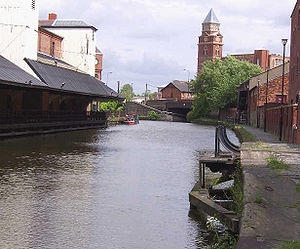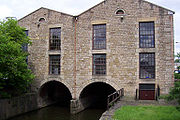
Wigan Pier
Encyclopedia

Canal
Canals are man-made channels for water. There are two types of canal:#Waterways: navigable transportation canals used for carrying ships and boats shipping goods and conveying people, further subdivided into two kinds:...
at the bottom of the Wigan flight of locks on the Leeds and Liverpool Canal
Leeds and Liverpool Canal
The Leeds and Liverpool Canal is a canal in Northern England, linking the cities of Leeds and Liverpool. Over a distance of , it crosses the Pennines, and includes 91 locks on the main line...
. It is a popular location for visitors and the local community in Wigan
Wigan
Wigan is a town in Greater Manchester, England. It stands on the River Douglas, south-west of Bolton, north of Warrington and west-northwest of Manchester. Wigan is the largest settlement in the Metropolitan Borough of Wigan and is its administrative centre. The town of Wigan had a total...
, Greater Manchester
Greater Manchester
Greater Manchester is a metropolitan county in North West England, with a population of 2.6 million. It encompasses one of the largest metropolitan areas in the United Kingdom and comprises ten metropolitan boroughs: Bolton, Bury, Oldham, Rochdale, Stockport, Tameside, Trafford, Wigan, and the...
, England, situated just a few hundred yards south-west of the town centre.
History
The original "pierPier
A pier is a raised structure, including bridge and building supports and walkways, over water, typically supported by widely spread piles or pillars...
" at Wigan was a coal loading staithe, probably a wooden jetty, where wagons from a nearby colliery were unloaded into waiting barges on the canal. The original wooden pier is believed to have been demolished in 1929, with the iron from the tippler (a mechanism for tipping coal into the barges) being sold as scrap.
The name Wigan Pier was possibly invented by and was brought to popular attention by George Formby, Sr.
George Formby, Sr.
George Formby , born James Booth, was an English comedian and musician. He was a star in Edwardian music halls, singing and clowning in a sardonic style that influenced the young Charlie Chaplin. Formby was plagued by ill-health and suffered from tuberculosis, but despite this was one of the...
in the Music Halls of the early twentieth century and later by George Formby, Jr. who incorporated it into his songs. Someone looking out of an excursion train to Southport
Southport
Southport is a seaside town in the Metropolitan Borough of Sefton in Merseyside, England. During the 2001 census Southport was recorded as having a population of 90,336, making it the eleventh most populous settlement in North West England...
in the fog and seeing a coal gantry asked "Where are we?" and was told "Wigan Pier". The tippler became the favoured location when people subsequently wanted to see it. There are references to it in songs such as On the Wigan Boat Express.
In 1937, Wigan was featured in the title of George Orwell
George Orwell
Eric Arthur Blair , better known by his pen name George Orwell, was an English author and journalist...
's The Road to Wigan Pier
The Road to Wigan Pier
The Road to Wigan Pier is a book by the British writer George Orwell, first published in 1937. The first half of this work documents his sociological investigations of the bleak living conditions amongst the working class in Lancashire and Yorkshire in the industrial north of England before World...
, which dealt, in large part, with the living conditions of England's working poor. In response to a critic, Orwell insisted "He liked Wigan very much — the people, not the scenery. Indeed, he has only one fault to find with it, and that is in respect of the celebrated Wigan Pier, which he had set his heart on seeing. Alas! Wigan Pier had been demolished, and even the spot where it used to stand is no longer certain." Some have embraced the Orwellian link, as it has provided the area with a modest tourist base over the years. "It seems funny to celebrate Orwell for highlighting all our bad points, but Wigan wouldn't be anywhere near as famous without him," says the Wigan Pier Experience's manager, Carole Tyldesley. "In the end George Orwell has proved to be a strong marketing tool." Others regard this connection as disappointing, considering it an insinuation that Wigan is no better now than it was at the time of Orwell's writing.
To see the difference, it is worth recalling a description of the canal scene from The Road to Wigan Pier: "I remember a winter afternoon in the dreadful environs of Wigan. All round was the lunar landscape of slag-heaps, and to the north, through the passes, as it were, between the mountains of slag, you could see the factory chimneys sending out their plumes of smoke. The canal path was a mixture of cinders and frozen mud, criss-crossed by the imprints of innumerable clogs, and all round, as far as the slag-heaps in the distance, stretched the ‘flashes’ — pools of stagnant water that had seeped into the hollows caused by the subsidence of ancient pits. It was horribly cold. The ‘flashes’ were covered with ice the colour of raw umber, the bargemen were muffled to the eyes in sacks, the lock gates wore beards of ice. It seemed a world from which vegetation had been banished; nothing existed except smoke, shale, ice, mud, ashes, and foul water."
Today, the slag heaps have been removed or landscaped with trees, the factories are closed or converted to housing and the canal is only used for recreational boating and fishing.
Existing buildings
The pier was at the end of a narrow gaugeNarrow gauge
A narrow gauge railway is a railway that has a track gauge narrower than the of standard gauge railways. Most existing narrow gauge railways have gauges of between and .- Overview :...
tramway
Tramway (mineral)
Tramways are lightly laid railways, sometimes worked without locomotives. The term is in common use in the United Kingdom, New Zealand, and elsewhere. In New Zealand, they are commonly known as bush tramways...
from a colliery. The wagons would be brought right to the edge of the canal to be tippled so that their contents went straight into the waiting barges. The original wooden pier is believed to have been demolished in 1929, with the iron from the tippler being sold as scrap. Because of the more recent pride in the area's heritage, a replica tippler, consisting of two curved rails, has been erected at the original location.

A warehouse with covered loading bays, converted into a museum of Victorian life (often mistakenly thought to be Wigan Pier), and the home to The Way We Were museum, was part of the Wigan Pier Experience museum and exhibition centre. The exhibition featured a Victorian
Victorian era
The Victorian era of British history was the period of Queen Victoria's reign from 20 June 1837 until her death on 22 January 1901. It was a long period of peace, prosperity, refined sensibilities and national self-confidence...
school room, a colliery disaster, the Second Boer War
Second Boer War
The Second Boer War was fought from 11 October 1899 until 31 May 1902 between the British Empire and the Afrikaans-speaking Dutch settlers of two independent Boer republics, the South African Republic and the Orange Free State...
and (on the top floor) a complete pub transported from Hope Street and reconstructed by shopping centre developers. The Wigan Pier Theatre Company used these displays to remind present generations of "The Way We Were" – not always a happy life. The attraction closed on 20 December 2007.
Gibson's Warehouse is a Victorian cotton warehouse, originally built in 1777, re-built in 1984 as The Orwell at Wigan Pier, is situated on the canalside.
Trencherfield Mill is a former cotton mill, located across the road from Wigan Pier - currently being converted into luxury apartments. It still contains the massive working steam engine which will be kept in the new development.
There are several bridges across the canal. Bridge #51 Pottery Changeline is a roving bridge
Roving bridge
A roving bridge, changeline bridge or turnover bridge is a bridge over a canal constructed to allow a horse towing a boat to cross the canal when the towpath changes sides...
, one which swaps the tow path from one side of the canal to the other, usually in such a way as to allow the horse pulling the barge to pass easily and without disconnecting its tow-rope. Bridge #50 Seven Stars Bridge is adjacent to the Seven Stars public house
Public house
A public house, informally known as a pub, is a drinking establishment fundamental to the culture of Britain, Ireland, Australia and New Zealand. There are approximately 53,500 public houses in the United Kingdom. This number has been declining every year, so that nearly half of the smaller...
, taking its name from "The Plough
Ursa Major
Ursa Major , also known as the Great Bear, is a constellation visible throughout the year in most of the northern hemisphere. It can best be seen in April...
" star constellation.
Elizabeth House, whose address is The Pier, Wigan, houses Keep Britain Tidy
Keep Britain Tidy
Keep Britain Tidy is a British campaign run by the Keep Britain Tidy environmental charity, which is part funded by the UK government. The majority of their campaigning is around the issue of litter. They have been using "Keep Britain Tidy" as their slogan for almost fifty years...
, an environmental charity.
Wigan Pier Nightspot is a night club on the southern bank of the Canal. The club plays music predominantly from the bouncy house genre.
Future
The area is set to undergo a further transformation with the development of a cultural "Wigan Pier Quarter" which will include a performance centre and retail outlets.Number 1 Wigan Pier, won a Civic Trust Award - the architect being Michael Stroud Churchward when it refurbished in the early part of the 1980s

